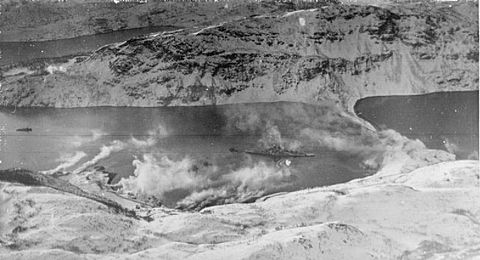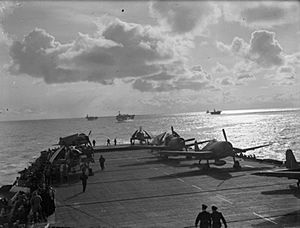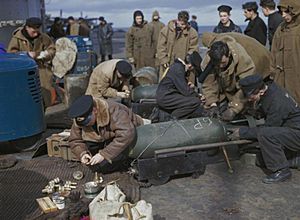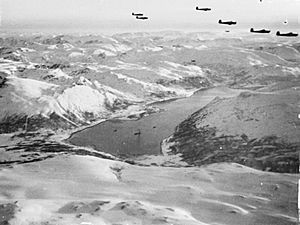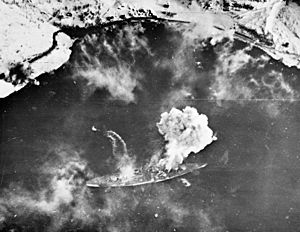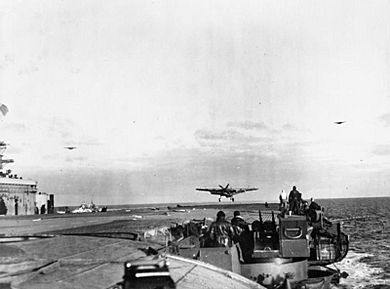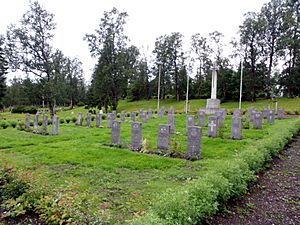Operation Tungsten facts for kids
Quick facts for kids Operation Tungsten |
|||||||
|---|---|---|---|---|---|---|---|
| Part of the Second World War | |||||||
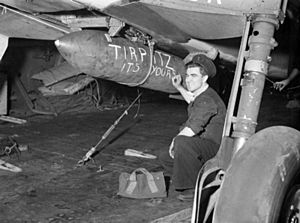 A Fleet Air Arm crewman chalks a message on the 1,600-pound bomb carried by a Fairey Barracuda of HMS Furious |
|||||||
|
|||||||
| Belligerents | |||||||
| Commanders and leaders | |||||||
| Strength | |||||||
| 40 dive bombers 80 fighters |
1 battleship Anti-aircraft batteries and ships |
||||||
| Casualties and losses | |||||||
| 9 fatalities 4 aircraft lost |
123 fatalities, 329 wounded 1 battleship and 5 other vessels damaged |
||||||
Operation Tungsten was a Royal Navy air raid during the Second World War. Its main goal was to attack the huge German battleship Tirpitz. The British wanted to damage or sink Tirpitz at its base in Kaafjord, Norway. They hoped to stop it from becoming fully ready for battle again after repairs.
The British worried that Tirpitz would attack important convoys. These convoys carried vital supplies to the Soviet Union. If Tirpitz was out of action, the Allies could use their own big warships for other tasks. After four months of planning, the British Home Fleet set sail on March 30, 1944. Aircraft from five aircraft carriers attacked Kaafjord on April 3. The attack was a surprise, and the British planes faced little resistance. Fifteen bombs hit the battleship. Fighter planes also shot at the ship's gun crews, causing many injuries. Four British planes and nine airmen were lost.
The attack did not sink Tirpitz. But it caused a lot of damage to its upper parts. 122 crew members died, and 316 were hurt. The German navy decided to repair the battleship. The repairs were finished by mid-July. The British tried more carrier raids against Tirpitz later in 1944. But none of these attacks were successful. Tirpitz was finally disabled and then sunk by Royal Air Force bombers in late 1944.
Why the Attack Happened
The German battleship Tirpitz was a big threat to the British during the Second World War. It was launched in February 1941. The German high command decided to send it to Norway. This was meant to stop an Allied invasion of Norway. It also threatened the convoys that sailed to the Soviet Union.
These convoys carried war supplies from the UK and Iceland. German air and naval units in Norway often attacked them. Tirpitz arrived in Norway in January 1942. It operated from safe anchorages in fjords. While Tirpitz was active, the Allies had to keep many powerful warships with the British Home Fleet. This was to protect against Tirpitz attacking the Arctic convoys.
The British attacked Tirpitz several times. On March 6, 1942, HMS Victorious tried to attack it with torpedo planes. But all twenty torpedoes missed. In 1942 and 1943, bombers from the Royal Air Force and Soviet Air Forces also tried to hit Tirpitz. They were not successful.
On September 23, 1943, two British X-class midget submarines managed to get past the defenses at Kaafjord. They placed explosives under Tirpitz. This attack caused a lot of damage. It put the battleship out of action for six months.
Repairs to Tirpitz were done at Kaafjord. It was too risky to move the damaged ship to Germany. Equipment and workers were sent from German ports. On February 10, 1944, 15 Soviet planes attacked the battleship. But they did not cause any damage. By March 17, most repairs were done.
At this time, the only other big German battleship, Scharnhorst, was sunk. This happened on December 26, 1943, during the Battle of the North Cape. After this, the Royal Navy stopped sending battleships to protect convoys. The Allies also had many anti-submarine and anti-aircraft ships. They could protect all Arctic convoys well.
The British government and Royal Navy were still worried about Tirpitz. They tracked its repairs using secret German radio signals and spy reports. They feared it could attack convoys in the Norwegian Sea. They also needed warships for the planned invasion of France. So, they decided to try and sink Tirpitz again.
Despite these worries, Tirpitz was not a huge danger. From late 1943, it could not go to sea for training. This was due to Allied attacks and a lack of fuel. Fuel shortages also meant the Germans could not move the battleship to new anchorages.
Planning the Attack
Attacking Tirpitz at Kaafjord was difficult. Another submarine raid was too hard. Intelligence showed that the battleship's underwater defenses were better. Also, more air patrols were flying in the area. The head of the Royal Air Force's Bomber Command refused to try a heavy bomber raid. He said Kaafjord was too far, and Tirpitz's guns would cause too many losses.
So, the task went to the Home Fleet's aircraft carriers. At this time, the large carriers HMS Furious and Victorious were ready. Four smaller escort carriers were also available.
Planning for the raid began in December 1943. Vice Admiral Bruce Fraser, the Home Fleet commander, was not hopeful. But he was convinced to try the operation. Vice Admiral Sir Henry Moore was put in charge of planning. The operation was first called "Operational Thrustful." Later, it was renamed "Operation Tungsten."
The attack was planned for mid-March 1944. This was when Allied intelligence thought Tirpitz would be ready. But it was delayed for two weeks. Victorious needed new radars. The British thought about canceling the operation. Victorious was also needed in the Indian Ocean. The United States Navy helped by sending USS Saratoga to the Eastern Fleet. This allowed Victorious to stay in the North Sea.
The attack plan focused on two dive-bombing raids. These would be done by Fleet Air Arm Fairey Barracuda planes. Each attack would have 21 Barracudas. They would be protected by 40 fighters. Vought F4U Corsairs from Victorious would guard against German planes. Grumman F4F Wildcat and F6F Hellcats from Furious and the escort carriers HMS Emperor, HMS Pursuer, and HMS Searcher would shoot at anti-aircraft batteries. They would also shoot at the battleship itself. Other planes from Furious and HMS Fencer would protect the fleet.
New 1,600-pound (730 kg) armor-piercing bombs were hoped to break through Tirpitzs thick deck armor. They needed to be dropped from 3,500 feet (1,100 m) or higher. Nine Barracudas would carry these big bombs. Twenty-two others would carry three 500-pound (230 kg) semi-armor-piercing bombs. These could hit the ship's upper decks. The rest of the planes would carry general-purpose bombs. These were meant to hurt the crew and cause underwater damage. Planes with high-explosive bombs would attack first. This was to knock out some of Tirpitzs anti-aircraft guns.
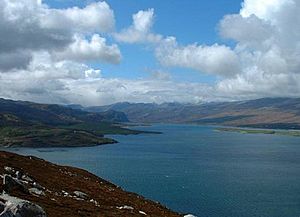
The Fleet Air Arm units trained hard from February 1944. They used Loch Eriboll in northern Scotland. This loch was like Kaafjord, surrounded by steep hills. Aircrews practiced flying around the hills. This helped them learn how to avoid German anti-aircraft guns. They also practiced attacking Tirpitz. A target the size of the battleship was marked on an island in the loch. It was bombed many times.
The Allies kept watching Tirpitz. In late February, HMS Chaser took photo analysts to Russia. Three Supermarine Spitfires and a Consolidated PBY Catalina joined them. The Spitfires flew over Kaafjord. They took detailed photos of Tirpitz and its defenses on March 12 and 13. The Catalina then flew these photos to the UK. German forces saw the Spitfires, but they did not increase their defenses.
On March 16, eight Allied submarines were sent to the Norwegian coast. German messages suggested Tirpitz might be leaving Kaafjord. Two days later, it was clear Tirpitz was not moving. The submarines were sent to other tasks. On March 21, British intelligence warned that Germany might send Tirpitz to attack convoys. So, Fraser was told to send battleships to protect the next Arctic Convoy.
The final decision for Operation Tungsten was made in mid-March. A German radio message said Tirpitz was almost ready for battle. It would do high-speed trials on April 1. The British attack force sailed at the same time as Convoy JW 58 left for the Soviet Union. This was hoped to make Germans think the warships were just supporting the convoy. A full practice attack was done at Loch Eriboll on March 28. From April 1, the Admiralty got hourly weather reports from Norwegian spies near Kaafjord.
The Attack Begins
The Royal Navy gathered a strong force for Operation Tungsten. The main attack force had two groups of Barracudas. These were 8 Wing and 52 Wing. A squadron from each wing was placed on each carrier. This allowed them to launch at the same time. Many of the airmen were from New Zealand, Canada, Australia, and South Africa.
The warships were split into two groups. Force One was led by Fraser on HMS Duke of York. It also included Victorious, HMS Anson, a light cruiser, and five destroyers. Force Two was led by Rear Admiral Arthur La Touche Bisset. It had Furious, the four escort carriers, five destroyers, and two tankers.
Tirpitz's base at Kaafjord was protected by anti-aircraft guns and fighter planes. There were four heavy anti-aircraft gun batteries and seven light ones on the shore. Several anti-aircraft ships were also near Tirpitz. The battleship itself had 68 anti-aircraft guns. There was also equipment to create a smoke screen to hide Tirpitz. The German Air Force had few fighters near Kaafjord. They also lacked fuel.
Force One left Scapa Flow on March 30. Force Two left later that day. The convoy had 49 merchant ships and 33 warships. German planes found the convoy on March 30. All German submarines in the Norwegian Sea were sent to attack it. But they did not find the convoy's battleship protection. Seventeen submarines attacked the convoy between April 1 and 3. None of the Allied ships were damaged. The escorts sank four submarines and shot down six German planes. The convoy reached the Soviet Union on April 6.
On April 1, Fraser decided to move the attack on Kaafjord forward by 24 hours. German signals said Tirpitz's trials were delayed until April 3. Fraser hoped to catch the battleship away from its usual safe spot. The weather was also very good for flying. The tankers and two destroyers left Force Two. They stayed 300 miles (480 km) north-west of Kaafjord to refuel destroyers. The rest of Force Two met Force One on April 2. Duke of York and two destroyers then sailed north-west. They would intercept Tirpitz if it had left Kaafjord. The rest of the Home Fleet went to the launch point.
The attack started early on April 3. All airmen woke up after midnight. They had a final briefing. Bombs were marked with messages for Tirpitz. Aircrews started boarding planes at 4:00 am. Flying operations began 15 minutes later. The warships were 120 miles (190 km) from Kaafjord. Ten Corsairs launched first. Then came 21 Barracudas. Seven Barracudas carried 1,600-pound (730 kg) bombs. The rest carried 500-pound (230 kg) or 600-pound (270 kg) bombs. After the Barracudas, 30 Wildcats and Hellcats launched. All planes were launched successfully by 4:37 am. The weather was perfect. German forces had not seen the British fleet.
The first wave flew low, just 50 feet (15 m) above the sea. This was to avoid German radar. They climbed to 7,000 feet (2,100 m) when they were 20 miles (32 km) from the coast. They reached land at 5:08 am. The planes approached Altenfjord from the west. They attacked Tirpitz over the hills of Kaafjord just before 5:30 am.
The British attack surprised Tirpitz. A German radar station saw the planes after they crossed the coast. But the battleship was not warned right away. Tirpitz was getting ready for high-speed trials. Its crew was busy unmooring the ship. Its five protective destroyers had already left. The warning came just before the planes appeared. The crew was still going to their battle stations. Not all watertight doors were closed.
The raid began with Hellcat and Wildcat fighters shooting at Tirpitz's anti-aircraft guns. They also shot at shore batteries. This caused many injuries to the battleship's gunners. It also damaged the main anti-aircraft control center. The fighters also shot at other ships in Kaafjord. The 21 Barracudas then attacked. They hit Tirpitz with one general-purpose bomb, three 500-pound (230 kg) semi-armor-piercing bombs, and three 1,600-pound (730 kg) bombs within 60 seconds. Ten bombs hit the battleship in total. Most did not go through the ship's armored deck. This was because they were dropped from too low. Hundreds of crew members died or were hurt. The ship's captain was among the wounded. The battleship drifted and ran aground. But it was quickly refloated. One Barracuda crashed, killing its three crew members. The surviving planes landed on the carriers between 6:19 am and 6:42 am.
The first planes of the second wave took off at 5:25 am. One Barracuda crashed after takeoff, killing its three crew. Another plane could not launch due to engine problems. Only two Barracudas in this wave had 1,600-pound (730 kg) bombs. Forty fighters went with the bombers. These included Corsairs, Wildcats, and Hellcats. All planes were launched by 5:37 am. They flew to Kaafjord without problems. The German defenses were now alert. But the smoke screen around Kaafjord was not yet thick enough to hide Tirpitz.
The second attack was like the first. Hellcat fighters shot at the anti-aircraft batteries. Wildcats attacked the battleship. Fighters also attacked German ships and a radio station. The Barracudas dive-bombed at 6:36 am. They hit Tirpitz with one 1,600-pound (730 kg) bomb and four 500-pound (230 kg) bombs within a minute. The German defenses had little warning. The smoke screen hid the British planes. So, the gunners had to fire blindly. They shot down only one Barracuda, killing its three airmen. The second wave landed on the carriers between 7:20 am and 7:58 am. A damaged Hellcat had to land in the water near the Canadian destroyer HMCS Algonquin. One Corsair was badly damaged in a landing accident. Both pilots survived.
During the air strikes, 25 Wildcat and Supermarine Seafire fighters protected the Home Fleet. Nine Fairey Swordfish torpedo bombers also flew anti-submarine patrols. No threat to the fleet appeared.
In the early afternoon of April 3, Moore thought about another raid. But he decided against it. Photos showed Tirpitz was badly damaged. Moore also knew his aircrew were tired. He did not want to risk them against alert defenses. So, he ordered the fleet to return to base. They arrived at Scapa Flow on April 6. King George VI and Prime Minister Winston Churchill sent messages of congratulations. But both Churchill and Cunningham worried that Tirpitz could be repaired.
After the Attack
The two attacks on Tirpitz mostly went as planned. The airmen found the defenses at Kaafjord very similar to their training area. One report said the operation was "almost an exercise." The Royal Navy's official historian said the attacks were "beautifully co-ordinated and fearlessly executed." The main difference was that many pilots dropped their bombs from too low. They wanted to hit Tirpitz better. But this might have meant some bombs did not have enough speed to go through the ship's armor. Nine Royal Navy airmen died during the raid.
Two bombs exploded in the water near Tirpitz. They made holes in its hull and caused flooding. But none of the 15 bombs that hit the battleship went through its main deck armor. So, its guns, ammunition rooms, and engines were not badly damaged. Most damage was to the ship's upper parts. The starboard aircraft catapult and crane were destroyed. Both of Tirpitzs floatplanes were also destroyed. One of its 150-millimetre (5.9 in) gun turrets was knocked out. Another 150-millimetre (5.9 in) turret was badly damaged. The officers' mess and several kitchens were ruined. The ship filled with smoke. Tirpitzs funnel was hit by bomb pieces. This badly damaged the boiler intakes. The starboard engine was knocked out by shock. Two boilers were disabled by saltwater used for firefighting. But the battleship could still move within Kaafjord.
Tirpitz's crew suffered many casualties. 122 sailors died, and 316 were wounded. This was 15 percent of the crew. Many of the dead and wounded were anti-aircraft gunners. They were hit by machine-gun fire from British fighters.
The British fighters also damaged four patrol boats and a large repair ship. The captain of an armed fishing boat died. Thirteen other sailors on these ships were wounded. A spy reported that no civilians were hurt. The local people were "extremely impressed" by the bombing. Another report six days later said the Germans thought it would take months to repair Tirpitz.
The commander of the Kriegsmarine, Grand Admiral Karl Dönitz, ordered the damage to Tirpitz to be repaired. Even though the battleship could no longer fight Allied convoys, keeping it active would tie down Allied naval forces. Repair work began in early May. Equipment and workers were brought from Germany. Tirpitz could move on its own by June 2. It could practice shooting by the end of June. All repairs were finished by mid-July.
During this time, Tirpitz's anti-aircraft guns were improved. More 20-millimetre (0.79 in) cannons were added. The 150-millimetre (5.9 in) guns were changed to fire at planes. Anti-aircraft shells were supplied for its main 380-millimetre (15 in) guns. The defenses of Kaafjord were also made stronger. More radar stations and observation posts were set up. The number of smoke generators around Tirpitz was increased.
After Operation Tungsten, British intelligence thought Tirpitz would be repaired within six months. So, Cunningham told Fraser to attack the battleship again. Cunningham did not think Barracudas could sink Tirpitz. But he hoped more air strikes would keep the battleship out of action longer. Fraser at first did not want to. He said the chances of success were low. The Germans would have stronger defenses. The weather would also be worse. But he eventually agreed. Moore sailed from Scapa Flow on April 21 to attack Kaafjord again. This raid, called Operation Planet, was canceled on April 24 due to bad weather. Two other attacks, Operation Brawn and Operation Tiger Claw, were also canceled in May because of bad weather.
More carrier raids were tried in July and August. This was after Allied intelligence learned that Tirpitz's repairs were almost done. During Operation Mascot, 42 Barracudas and 40 fighters attacked Tirpitz on July 17. But they did not hit it. The battleship was hidden by a smoke screen. Four more carrier raids were done between August 22 and 29 during Operation Goodwood. But these only caused light damage to the battleship.
In late August, it was decided that more Fleet Air Arm attacks should not be tried. The Germans could now cover Tirpitz in smoke before Barracudas could reach it. Also, these planes could not carry bombs big enough to cause heavy damage. Since destroying Tirpitz was still important, the task was given to Bomber Command. On September 15, heavy bombers attacked Kaafjord. They refueled at bases in northern Russia. They caused damage to the battleship that could not be repaired. After this, Tirpitz sailed to Tromsø. It was to be used as a fixed coastal defense battery. Operation Obviate, another heavy bomber attack on October 29, caused only minor damage. A third raid, Operation Catechism, happened on November 12. Tirpitz was hit by several Tallboy bombs. It turned over, and many of its crew died.


